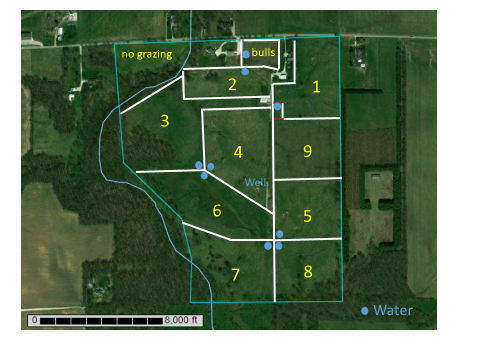What does the word “stockpile” mean to you? My understanding of the meaning is to “store away for future use.” Recently because of Covid-19, some families were stockpiling toilet paper. Some may have thought that the most-right word was hoarding! Within forage-livestock agriculture, the word stockpiling refers to growing forage in the pasture that can be used at a later time. A properly managed rotational stocking system allows this to happen. Livestock can graze other paddocks (cells) in the late summer and early fall while approximately one-fourth of the acreage is restricted from the livestock so forage can grow to be grazed in the late fall and possibly the early winter.

Rotational grazing a pasture permits stockpiling forage for grazing in the late fall and early winter. (Photo Credit: Ron Lemenager, Purdue University Extension Beef Specialist)
Application of up to 50 pounds of nitrogen per acre to stockpiled grass-dominant paddocks in late August to early September increases forage yield. Amount of increase will be dependent upon forage species, adequate rainfall, temperature, date of application, and the remaining length of the growing season. Tall fescue is an excellent stockpiling forage as it can accumulate more dry matter as compared to other grasses when temperature cools to 50 degrees F. If the paddocks have a dry matter yield contribution of 30 percent or more from legumes, there is no need to apply the nitrogen. Fertilizer prices remain high, but grazing pasture growth is likely a cheaper alternative than feeding hay that might be needed in late winter. If hay inventory is used before pasture growth begins in late April or early May 2023, purchasing hay to meet the nutritional needs of livestock will likely have high cost.
Carefully consider whether the number of livestock being grazed and hay inventory on hand justifies the opportunity to add nitrogen fertilizer to some paddocks to boost grass yield to extend the grazing season.


